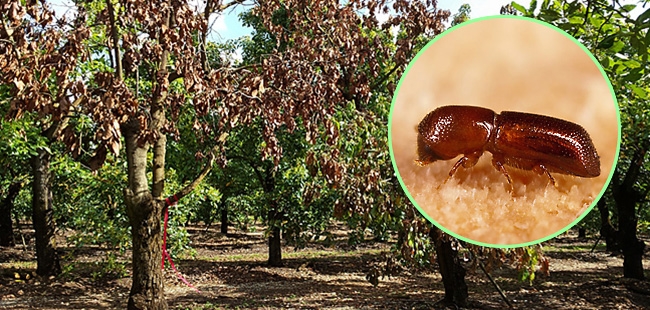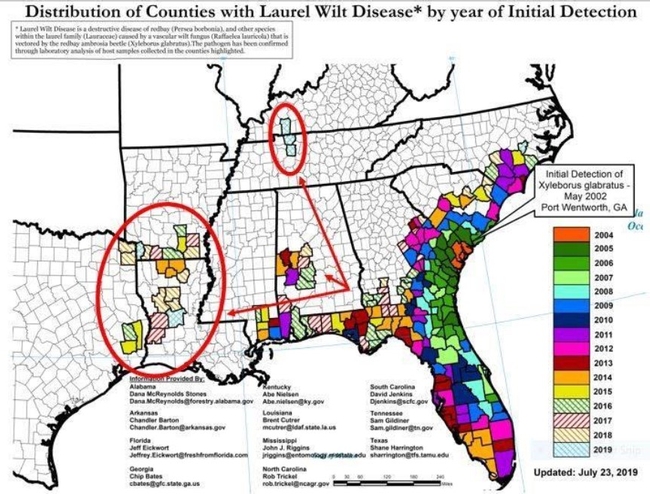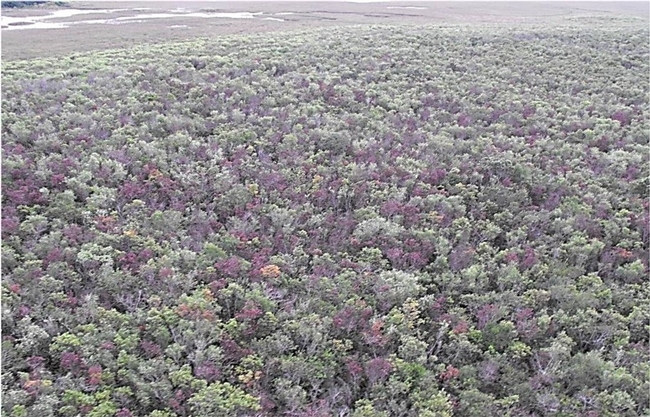
A Florida Avocado Grower Letter
Laurel Wilt Disease has been on the radar since 2002 when it became apparent that trees related to avocado were dying in the Georgia area. The Lauraceae family comprises a major portion of the evergreen tree species in the southeast. It's a fungal disease spread by the red bay ambrosia beetle. Since its introduction, the pest/disease complex has spread throughout the Southeast US, causing significant death and economic loss in forested areas. Since about 2011, it has been causing significant damage to the avocado groves in the Miami area. A massive amount of energy has been put into studying the control of the disease, but as yet, there are no clear solutions once a tree is infected. Tree removal is the answer to contain the spread.
This is a grower letter describing the frustration of dealing with Laurel Wilt Disease in Florida and an alert to California growers to get prepared for it.
Homestead, Florida
(305) 972-9499
cdlt1948@yahoo.com
DLT Farms LLC
October 27, 2019
Open Letter to Avocado Producers:
I grow tropical avocados commercially in Homestead, Florida. That's been my passion for the last 16 years, The last five years have been a frustrating nightmare caused by Laurel Wilt. This morning I marked three more trees for extraction in addition to the 10 trees I marked three days ago. I lose about 20-25 a month and it's on the rise.
The largest avocado-producing areas are free of the problem at the moment. In South Florida, tropical avocado is a very small industry with little economic and political influence, as a result not much attention is paid to this crises. In the Homestead, Florida avocado region the pathogen and vectors are everywhere. There are orchards that disappear from one year to the next. Unfortunately, we have been on the front lines of this disease.
This creates an opportunity for the rest of the avocado producing areas, so far free of this disease to do research in this area. There is a lot of research to be done and as time goes on we gain more experience. Here, there is access to adult trees in the field for testing and research. This is not the case for areas in which the disease has not made its appearance.
I only mention some investigations that could be pending:
Some trees die in a week, however there are trees that look resistant to Laurel Wilt, they have tested positive from root to canopy, proven on multiple occasions and methodologies, yet they are still alive and show no symptoms of the wilt. I know of two, one in particular I call 9-7, is positive since January 2019 and continues alive and recovering. Personally I think this tree is talking to us, however there are no funds to see what it tells us.
Early detection in the process is vital to early removal of diseased trees, before other trees acquire the disease. It is essential to determine whether the tree is contaminated with little pathogen, to extract it before it contaminates adjacent trees. There is no data on the time between when a tree is contaminated and when the first sign of "sadness" becomes visible. Less than a week ago I detected a little sadness in a branch. When cutting it, it looked positive for wilt, I continued to check three more trees on the same row and all three tested positive at various levels without visible symptoms. Root contamination moves unnoticed for weeks or months. This type of root contagion remains an observable presumption of farmers and has not been investigated.
Some producers believe that there are two or more strains of the fungus that causes the disease, (Raffaelea Lauricola), one much more aggressive than others. A full DNA study is complicated and costly. As I understand it, it hasn't been done and there are no plans.
Other producers began doing thermal treatments on infected and stumped trees. I tried on 8 of my trees. All are alive and doing well, the two oldest are 17 months old and continue to grow. On the other hand, the eight have tested positive for Laurel Wilt, post-treatment. There is no scientific data to understand what is going on and what opportunities this offers.
What attracts vectors and what can farmers do? Many growers are gaining experience of their own. I stopped injecting phosphorous acid to treat Phytophthora because I have noticed that these trees have a higher frequency of vector inoculation than others not injected. I suspect why, but we don't have a scientific foundation to know what's going on.
Can trees be vaccinated with some form of vaccine to increase resistance or defense against the pathogen?
And so on, I could mention a lot more.
Looking back we knew it was coming, but we didn't prepare enough, partly because it wasn't always easy to test in the field and there were a lot of restrictions on conducting test in greenhouses and we just didn't believe it or wanted to invest funds in research. Some thought it would never come.
We all see these bark beetles moving around the world with little or no restriction. One day any area can wake up to the bad news.
I can tell you this: you can imagine this disease in your grove, more or less we know what it does, you can read articles, watch YouTube videos, after you finish your imagination exercise, I can tell you as a grower dealing with this every day, MULTIPLY IT BY 10 !
Please, support research in the area where it can best be done. Get ahead of it.
Signed,
Carlos de la Torre
Keep abreast of Laurel Wilt Disease!
You can see presentations that have been made by a University of Florida research contingent which spoke to avocado growers this summer, 2019:
You can also hear a webinar about the pest/disease complex by UCR's Monique Rivera:
Photos: Symptoms of Laurel Wilt Disease in avocado. Distribution map over time of Laurel Wilt Disease in the Southeast. Image of Georgia forest affected by Laurel Wilt Disease.

laurel-wilt-and-avocado-trees

Laurel wilt map

laurel wilt forest death
